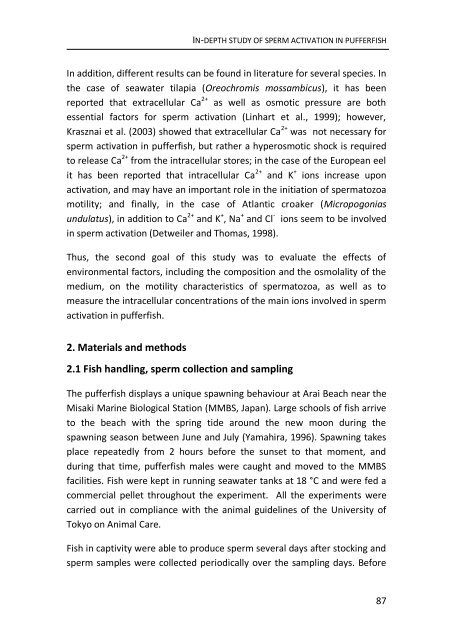chapter 3 - RiuNet
chapter 3 - RiuNet
chapter 3 - RiuNet
You also want an ePaper? Increase the reach of your titles
YUMPU automatically turns print PDFs into web optimized ePapers that Google loves.
IN-DEPTH STUDY OF SPERM ACTIVATION IN PUFFERFISH<br />
In addition, different results can be found in literature for several species. In<br />
the case of seawater tilapia (Oreochromis mossambicus), it has been<br />
reported that extracellular Ca 2+ as well as osmotic pressure are both<br />
essential factors for sperm activation (Linhart et al., 1999); however,<br />
Krasznai et al. (2003) showed that extracellular Ca 2+ was not necessary for<br />
sperm activation in pufferfish, but rather a hyperosmotic shock is required<br />
to release Ca 2+ from the intracellular stores; in the case of the European eel<br />
it has been reported that intracellular Ca 2+ and K + ions increase upon<br />
activation, and may have an important role in the initiation of spermatozoa<br />
motility; and finally, in the case of Atlantic croaker (Micropogonias<br />
undulatus), in addition to Ca 2+ and K + , Na + and Cl - ions seem to be involved<br />
in sperm activation (Detweiler and Thomas, 1998).<br />
Thus, the second goal of this study was to evaluate the effects of<br />
environmental factors, including the composition and the osmolality of the<br />
medium, on the motility characteristics of spermatozoa, as well as to<br />
measure the intracellular concentrations of the main ions involved in sperm<br />
activation in pufferfish.<br />
2. Materials and methods<br />
2.1 Fish handling, sperm collection and sampling<br />
The pufferfish displays a unique spawning behaviour at Arai Beach near the<br />
Misaki Marine Biological Station (MMBS, Japan). Large schools of fish arrive<br />
to the beach with the spring tide around the new moon during the<br />
spawning season between June and July (Yamahira, 1996). Spawning takes<br />
place repeatedly from 2 hours before the sunset to that moment, and<br />
during that time, pufferfish males were caught and moved to the MMBS<br />
facilities. Fish were kept in running seawater tanks at 18 °C and were fed a<br />
commercial pellet throughout the experiment. All the experiments were<br />
carried out in compliance with the animal guidelines of the University of<br />
Tokyo on Animal Care.<br />
Fish in captivity were able to produce sperm several days after stocking and<br />
sperm samples were collected periodically over the sampling days. Before<br />
87
















